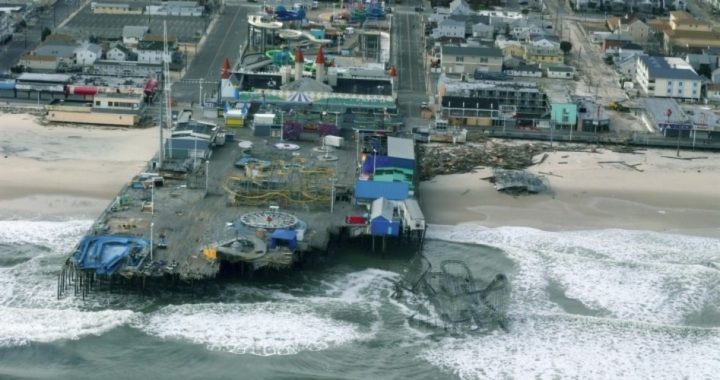
Hurricane Sandy, appropriately dubbed “Frankenstorm,” proved to be everything geologists warned it would be and more. The superstorm has left a trail of destruction across the Northeast and Mid-Atlantic, has claimed the lives of over 50 people, including three children, and caused approximately $20 billion in damage.
Hurricane Sandy is what analysts are calling a once-in-a-generation storm because of the various elements that have separated this storm from other historic storms. Frankenstorm is a combination of a late season hurricane, Sandy, that was pushed toward land by a high-pressure system near Greenland, combined with a winter system from the west that prevented the storm from moving back out to sea. The combination, along with Arctic air from the North set the stage for a unique storm. These conditions were exacerbated by a full moon, a time when tides are at their highest.
“The total is greater than the sum of the individual parts,” Louis Uccellini, the environmental prediction chief of the National Oceanic and Atmospheric Administration, told the Associated Press.
When Sandy made landfall south of Atlantic City, New Jersey, it had the second-lowest atmospheric pressure of any storm to make landfall north of Cape Hatteras, North Carolina, notes the Washington Post. In general, the lower the pressure, the more intense the storm is.
Sandy has wreaked havoc on a number of areas in the northeast region of the United States.
The most dramatic reports of Sandy’s devastation are coming out of New York City.
Forbes reports, “A giant electrical transformer station on East 14th Street exploded … in a blue-white fireball-knocking out power to most of lower Manhattan (including Forbes headquarters).”
Parts of lower Manhattan in New York were flooded as water poured into the Brooklyn-Battery and Queens Midtown tunnels, forcing the New York City public transportation system to shut down.
The foundations of the new World Trade Center were also flooded. A surge of floodwater in Fire Island, off the shore of Long Island, destroyed homes and left 60 people trapped.
By Monday, six million New Yorkers were without electricity, and officials warned that the power could be off for days. New York mandated an evacuation of 375,000 people in low-lying areas of the city.
Thousands of flights were cancelled at the New York metropolitan area’s major airports, and the power company was forced to shut power off to part of Lower Manhattan to make restoration of power following the storm more quickly.
And New York University’s Langone Medical Center was forced to move over 200 critical care patients to nearby facilities as its generator died.
New York City Mayor Michael Bloomberg has placed the city’s death toll at 18.
A fire blazed through the Breezy Point neighborhood of Queens, which destroyed 80 homes, including one which belonged to Congressman Robert L. Turner.
The New York Stock Exchange was closed on Monday and Tuesday, the first unscheduled closures since the attacks of September 11th, but has resumed trading on Wednesday.
Some New York City buses have resumed service. Flooding continues to prevent Amtrak from resuming service. Likewise, the head of the Metropolitan Transit Authority states the subway system will be down for at least a week.
New Jersey also bore extensive damage from the storm. Hurricane Sandy destroyed Atlantic City’s iconic boardwalk, and despite the evacuation orders for Atlantic City and the state’s barrier islands, many people stayed behind. At least six people were killed, including a couple who were killed by a falling tree while getting out of their pickup truck as their young children watched.
Massive flooding struck major areas in New Jersey including Newark, Jersey City, and Hoboken. Likewise, boats that were sitting in marinas were thrown into roadways and people’s backyards, while vacation homes on the shore were utterly destroyed beyond recognition.
The Seaside Heights historic boardwalk amusement park was destroyed. Parts of the famous Jet Star rollercoaster were seen in the ocean water.
It’s “like nothing we’ve ever seen,” New Jersey Governor Chris Christie said. “There are no words to describe what so many New Jersey residents experienced over the last 24 hours and what we will have to contend with over the coming days, weeks and months.”
National Guard troops arrived in Hoboken on Tuesday amidst live wires found to be dangling in floodwaters, ready to help evacuate residents and distribute emergency supplies.
And Governor Christie announced that PATH trains that connect New Jersey to Manhattan would be out of service for at least 10 days because of flooding.
Thousands of Connecticut homes were pounded by flooding and wind gusts. One person died in the city of Mansfield after being pinned by a tree, reported NBCConnecticut.com.
Connecticut Gov. Dannel Malloy called the state’s coastal flooding “the worst water event in the state’s history.”
Some residents returned to their homes in Fairfield on kayaks and canoes.
Delaware’s Governor Jack Markell ordered the evacuation of over 50,000 coastal residents, but areas expected to be hardest hit such as Rehobeth Beach and Dewey Beach were spared major structural harm.
Hurricane Sandy slammed Washington, D.C., virtually shutting down the federal government and closing the subway system.
However, the Supreme Court of the United States managed to remain open on Monday to hear two cases, reports the L.A. Times.
In Pennsylvania, a Berks County man was killed by a falling tree outside of his home. Winds in Philadelphia neared 70 mph, and waves reached as high as 12 feet in Delaware Bay.
Maine, Rhode Island, North Carolina, Vermont, Massachusetts, Virginia, Ohio, Michigan, and New Hampshire all faced rough winds and large-scale flooding.
In the Atlantic off North Carolina, a replica of HMS Bounty was sunk by Sandy’s winds and waves. Captain Robin Walbridge was on board the ship and is presumed to be dead, but the Coast Guard managed to rescue 14 other crewmembers from the ship. One other crewmember had died after being rescued from the waters.
Maryland’s and West Virginia’s experience was unique, as they dealt with significant snowfall. Blizzard warnings were issued all throughout the weekend as well as on Monday.
In Maryland, a power outage at a water treatment plant has caused a major sewage leak, resulting in two million gallons of human waste to pour into the Little Patuxent River every hour. Power was restored to the plant on Tuesday.
Many expected that the storm would take a devastating toll on Ocean City, Maryland, and while hurricane-force winds and nearly a foot of rain dealt some blows, there were fortunately no significant injuries or deaths there. The National Guard and Ocean City officials transferred 49 people from flood-prone homes, but some had stayed behind, facing flooding.
Three deaths in West Virginia have been blamed on the snow, one from a weather-related accident, and two others from heart attacks brought on by snow clean-up.
Nearly three feet of snow fell in the mountains of Maryland and West Virginia, while lighter snow fell in Virginia, North Carolina, Tennessee, Kentucky and Ohio.
“By sunrise Wednesday, 16 different locations in three states had reported at least two feet of snow,” reports weather.com meteorologist Nick Wiltgen.
Meanwhile states are making efforts to begin the long and painful recovery process. President Obama has signed federal emergency declarations for New Jersey, as well as nine other states, and the District of Columbia.
The cost of damages is estimated to be at $20 billion, with an additional $10 to $30 billion in lost business, according to IHS Global Insight.
Photo: The view of storm damage over the New Jersey Shore in Seaside Heights, N.J., Oct. 31, 2012, from a helicopter traveling behind the helicopter carrying President Obama and New Jersey Gov. Chris Christie, as they viewed storm damage from Hurricane Sandy: AP Images




